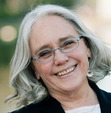Edith Maxwell's Blog, page 234
April 18, 2016
A Walk Around the Frog Ledge Town Green
By Liz, desperate to escape from book jail and wind up on a beach somewhere….
That sounds like a movie we might all be familiar with, doesn’t it? Anyway, it’s true – I am still locked away in book jail, and the clock is ticking. So because I am chained to my desk, I thought I’d take you all on a virtual walk around the Frog Ledge Town Green with Stan.

Here we go – leaving Stan’s house and heading across the street to the green!
Heading down the path….

 Beautiful view!
Beautiful view!
The traditional New England church.
 Stopping to admire the flowers…..
Stopping to admire the flowers….. and visit with some pups resting during their walk!
and visit with some pups resting during their walk!
 Some history.
Some history.
The beautiful tree behind the library.

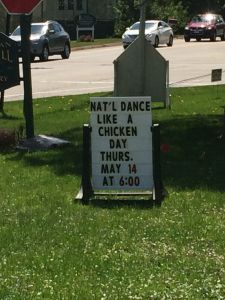 Some typical fun things to do in Frog Ledge….
Some typical fun things to do in Frog Ledge….
And finally, heading home. Thanks for walking with me!
 Check out my Pinterest boards for more Frog Ledge fun. See you when I make bail! Hopefully I’ll be out in time for National Dance Like a Chicken Day….
Check out my Pinterest boards for more Frog Ledge fun. See you when I make bail! Hopefully I’ll be out in time for National Dance Like a Chicken Day….
Readers, what’s your favorite place to walk or jog?
Filed under: Liz's posts Tagged: Frog Ledge, jog, New England, Pawsitively Organic Mysteries, town green, walk

April 15, 2016
A Wicked Welcome to the Agatha Best First Nominees
By Julie, waiting for spring to come to Somerville
 Dear readers, you have all been on my publishing journey with me, capped off by the publication of Just Killing Time last October. I was thrilled when it was nominated for a Best First Novel Agatha Award. Icing on the cake–getting to know the other four nominees. Ellen Byron, Tessa Arlen, Art Taylor, Cindy Brown and I have been doing a blog tour, talking about our books, and our paths to publication. For each blog visit we are answering different questions.
Dear readers, you have all been on my publishing journey with me, capped off by the publication of Just Killing Time last October. I was thrilled when it was nominated for a Best First Novel Agatha Award. Icing on the cake–getting to know the other four nominees. Ellen Byron, Tessa Arlen, Art Taylor, Cindy Brown and I have been doing a blog tour, talking about our books, and our paths to publication. For each blog visit we are answering different questions.
Here are the questions of the day:
Is the book you are nominated for the first book you wrote? And from the time you decided to write a novel how long did it take you to get published?
 ELLEN BYRON: I’m a playwright who turned to writing for television to
ELLEN BYRON: I’m a playwright who turned to writing for television to 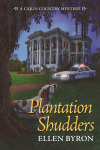 make a living. But during a few months of downtime, a friend started a writers’ group and I thought I’d try writing fiction. I’ve always loved mysteries, but didn’t know if I had the chops to write one. So I decided to challenge myself and just do it! The first book I wrote was called Reality Checked (now known as You Can Never Be Too Thin or Too Dead). I discovered the Malice-Domestic Convention through a Google search, applied for a William F. Deeck-Malice Domestic Grant and won one in 2013. YAY! It took nine months to find a book agent. Boo. But he loved the book and sent it out. YAY! And it has yet to sell. Boo. But… while I was waiting for that possible sale, I wrote a second book, Plantation Shudders, and that sold in a two (now four) book deal to Crooked Lane Books. So… DOUBLE YAY! From the beginning of that writers group to selling Plantation Shudders took about three years, and it launched nine months later. And I’ve been saying YAY! ever since.
make a living. But during a few months of downtime, a friend started a writers’ group and I thought I’d try writing fiction. I’ve always loved mysteries, but didn’t know if I had the chops to write one. So I decided to challenge myself and just do it! The first book I wrote was called Reality Checked (now known as You Can Never Be Too Thin or Too Dead). I discovered the Malice-Domestic Convention through a Google search, applied for a William F. Deeck-Malice Domestic Grant and won one in 2013. YAY! It took nine months to find a book agent. Boo. But he loved the book and sent it out. YAY! And it has yet to sell. Boo. But… while I was waiting for that possible sale, I wrote a second book, Plantation Shudders, and that sold in a two (now four) book deal to Crooked Lane Books. So… DOUBLE YAY! From the beginning of that writers group to selling Plantation Shudders took about three years, and it launched nine months later. And I’ve been saying YAY! ever since.
 TESSA ARLEN: I have always enjoyed writing but I had never written a book before Death of a Dishonorable Gentleman. When I finished a
TESSA ARLEN: I have always enjoyed writing but I had never written a book before Death of a Dishonorable Gentleman. When I finished a  mammoth first draft (145,000 words!) in 2009 I read up a bit about plot and structure and then set to work in earnest. After about a year and a half I had what I thought might be a worthwhile book. It was my husband who suggested I find an agent and this took me about eight months or so. In my ignorance I went with the wrong one! She was awful –she would get on the phone and talk for hours but we never seemed to get anywhere and after several months I realized I had a real dud on my hands. And then my wonderful agent Kevan Lyon contacted me and said had just read my manuscript, loved it and that she would like to represent me. Within five weeks she had negotiated a two book (now four book) deal with Thomas Dunne/Minotaur and DEATH OF A DISHONORABLE GENTLEMAN was published in January 2015. Now here we are up for an Agatha award. Believe me NO ONE is more staggered by all of this than me!
mammoth first draft (145,000 words!) in 2009 I read up a bit about plot and structure and then set to work in earnest. After about a year and a half I had what I thought might be a worthwhile book. It was my husband who suggested I find an agent and this took me about eight months or so. In my ignorance I went with the wrong one! She was awful –she would get on the phone and talk for hours but we never seemed to get anywhere and after several months I realized I had a real dud on my hands. And then my wonderful agent Kevan Lyon contacted me and said had just read my manuscript, loved it and that she would like to represent me. Within five weeks she had negotiated a two book (now four book) deal with Thomas Dunne/Minotaur and DEATH OF A DISHONORABLE GENTLEMAN was published in January 2015. Now here we are up for an Agatha award. Believe me NO ONE is more staggered by all of this than me!

ART TAYLOR: Looking back over my short story output, I think that I have more failed projects that successful ones—story ideas that  didn’t pan out, projects that never fully cohered, or even finished, polished manuscripts that simply couldn’t find the right home—and that’s the case with the novel manuscripts I’ve had as well; there are at least four of them in one form or another in file cabinets or filed away in one place or another on my computer. With On The Road With Del & Louise: A Novel in Stories, the process was very much a different one, since I’d never actually thought of it as a novel when I first started writing it; Del and Louise were originally characters in a short, standalone adventure, and it was only over some time—several years—that I began to see that story and other tales as part of a longer and more complex narrative arc, one tied together by the two characters’ search for who they are, what they mean to one another, and where they might find a place to call their own, both a physical space and an emotional one. A couple of the individual stories found their own home at Ellery Queen’s Mystery Magazine before the good folks at Henery Press became interested in the longer novel project, so that road to publication had a couple of welcome stops en route to the book’s final destination.
didn’t pan out, projects that never fully cohered, or even finished, polished manuscripts that simply couldn’t find the right home—and that’s the case with the novel manuscripts I’ve had as well; there are at least four of them in one form or another in file cabinets or filed away in one place or another on my computer. With On The Road With Del & Louise: A Novel in Stories, the process was very much a different one, since I’d never actually thought of it as a novel when I first started writing it; Del and Louise were originally characters in a short, standalone adventure, and it was only over some time—several years—that I began to see that story and other tales as part of a longer and more complex narrative arc, one tied together by the two characters’ search for who they are, what they mean to one another, and where they might find a place to call their own, both a physical space and an emotional one. A couple of the individual stories found their own home at Ellery Queen’s Mystery Magazine before the good folks at Henery Press became interested in the longer novel project, so that road to publication had a couple of welcome stops en route to the book’s final destination.
 JULIANNE HOLMES: Not even close! I have been thinking a lot about my journey, especially given all that is going on. It was about fifteen years ago
JULIANNE HOLMES: Not even close! I have been thinking a lot about my journey, especially given all that is going on. It was about fifteen years ago that I said aloud “I want to write a mystery novel.” The first thing I had to do was figure out how to write a book. And then I wrote one, which is in a drawer and will never see the light of day. Then I wrote another one, about an ex-cop who runs a theater. That book taught me how to edit. I’d love to see that book in print at some point. I noodled with other ideas, and then this series came into my life. Fifteen years is a long time to hold on to a dream, but it is so worth it!
that I said aloud “I want to write a mystery novel.” The first thing I had to do was figure out how to write a book. And then I wrote one, which is in a drawer and will never see the light of day. Then I wrote another one, about an ex-cop who runs a theater. That book taught me how to edit. I’d love to see that book in print at some point. I noodled with other ideas, and then this series came into my life. Fifteen years is a long time to hold on to a dream, but it is so worth it!
 CINDY BROWN: Like Ellen, I wrote plays before fiction. But then Ivy Meadows came knocking on my mind’s door. A sassy, slightly silly
CINDY BROWN: Like Ellen, I wrote plays before fiction. But then Ivy Meadows came knocking on my mind’s door. A sassy, slightly silly  actress and part-time PI, Ivy didn’t fit into a play, so I decided to write a novel. I’d been reading mysteries since grade school, was writing professionally (mostly as a copywriter and scriptwriter back then) and had written twenty or so plays and screenplays—how hard could it be? Riiiiight. My first attempts were pitiful. As a playwright, my sense of dialogue was good, but I kept forgetting things like, oh, setting and description. So I took classes and workshops and worked in writers groups and rewrote and rewrote and rewrote. I even took the book apart and started over. Twice. The second time was at the bequest of Kendel Lynn from Henery Press, who helped me fix a fatal flaw (mystery pun intended) and whip the book into readable shape. It’s difficult to say how long it took me to write Macdeath, because I put it aside several times—twice to write non-fiction books for ghostwriting clients, and once to work on The Sound of Murder when I thought Macdeath might not sell. I’m soooo happy it did—I love my characters like they’re my friends.
actress and part-time PI, Ivy didn’t fit into a play, so I decided to write a novel. I’d been reading mysteries since grade school, was writing professionally (mostly as a copywriter and scriptwriter back then) and had written twenty or so plays and screenplays—how hard could it be? Riiiiight. My first attempts were pitiful. As a playwright, my sense of dialogue was good, but I kept forgetting things like, oh, setting and description. So I took classes and workshops and worked in writers groups and rewrote and rewrote and rewrote. I even took the book apart and started over. Twice. The second time was at the bequest of Kendel Lynn from Henery Press, who helped me fix a fatal flaw (mystery pun intended) and whip the book into readable shape. It’s difficult to say how long it took me to write Macdeath, because I put it aside several times—twice to write non-fiction books for ghostwriting clients, and once to work on The Sound of Murder when I thought Macdeath might not sell. I’m soooo happy it did—I love my characters like they’re my friends.
Here are some of the other stops on our blog tour:
Writers Who Kill
Mysteristas
Washington Independent Review of Books
Stiletto Gang: April 18
Chicks on the Case: April 25
Criminal Minds: April 22
Filed under: Julie's posts, Uncategorized Tagged: Agatha awards, Art Taylor, Best First, Cindy Brown, Ellen Byron, Julianne Holmes, Tessa Arlen

April 14, 2016
The Agatha Best Short Story Nominees!
by Barb, who’s getting excited about seeing everyone at Malice
 Today, the Wickeds are delighted to host the nominees for the Agatha Award for Best Short Story. The Agathas are given every year at the Malice Domestic conference to the best examples of traditional mysteries. You can see the nominees in all the categories here. You can also access and read all the nominated short stories, which I highly recommend.
Today, the Wickeds are delighted to host the nominees for the Agatha Award for Best Short Story. The Agathas are given every year at the Malice Domestic conference to the best examples of traditional mysteries. You can see the nominees in all the categories here. You can also access and read all the nominated short stories, which I highly recommend.
As you might guess, from my years as a co-editor at Level Best Books, I have read tons of short stories. After I read the nominated stories, I had SO. MANY. QUESTIONS.
Thanks so much to the nominees for indulging me today.
Barb Ross: Barb Goffman, your story, “A Year Without Santa Claus” is genre-bending, combining a cast of magical beings with a crime story. What was your inspiration for this story? Was crossing genres something you did consciously, or was it the result of the tale that came to you?
 Barb Goffman: The main character’s voice came to me in a dream. I heard a woman complaining about someone having killed the Easter Bunny. When I woke up, I tried to think how I could use this character in a mystery set in New Jersey. (There was an open call at that time for NJ-based mysteries.) I wrote the first page, having figured out that my main character, Annabelle, was the head of everything magical that happens in NJ and that Santa wouldn’t come to NJ this year because there was a killer on the loose, killing mortals who dressed as magical beings. Annabelle couldn’t allow Santa to skip Jersey (think of the poor children), so she decided she had to catch the killer. It was a good setup. But then I got stuck on the plot. It took me more than three years to figure out how to proceed. (Yes, I missed the deadline for the NJ anthology.)
Barb Goffman: The main character’s voice came to me in a dream. I heard a woman complaining about someone having killed the Easter Bunny. When I woke up, I tried to think how I could use this character in a mystery set in New Jersey. (There was an open call at that time for NJ-based mysteries.) I wrote the first page, having figured out that my main character, Annabelle, was the head of everything magical that happens in NJ and that Santa wouldn’t come to NJ this year because there was a killer on the loose, killing mortals who dressed as magical beings. Annabelle couldn’t allow Santa to skip Jersey (think of the poor children), so she decided she had to catch the killer. It was a good setup. But then I got stuck on the plot. It took me more than three years to figure out how to proceed. (Yes, I missed the deadline for the NJ anthology.)
Did I cross genres consciously? Well, the magical realism aspect of the story came from the dream. Since I write crime stories, it seemed obvious to merge the two genres. It ended up working out well because it allowed me to get my sleuth access to police files (through a magical snap of the fingers) without subjecting her to police procedural rules. Giving her that ability helped move the story along quickly. But I didn’t want her to solve the crime using magic. That would have felt like a cheat. So while she used her magic to get background information, in order to figure out whodunit, she had to use old-fashioned sleuthing techniques available to any mortal. It was fun to write. And, I hope, for people to read.
Barb Ross: B.K. Stevens, one of the cleverist things about your very clever story, “A Joy Forever” is that you never reveal the gender of your protagonist, who is far from a disembodied voice, but is a very strong presence in the story. Why did you make this story choice? Was it your intention from the beginning or did it evolve?
 It evolved. In early drafts of the story, the narrator was unambiguously male—a young man named Dan, Mike Mallinger’s nephew. But although I liked other elements of the story, the narrator’s voice always seemed off to me. It was too flat, too bland. In one sense, that was all right. After all, in this story, the narrator is essentially a spectator and a reporter—or maybe I should say a photographer, since that’s the narrator’s profession. I didn’t want Dan to be so dynamic that he’d distract attention from the central drama unfolding between Mike and Gwen. But I also didn’t want the narrator to be simply two dimensional, so I looked for a way to connect Dan to the story’s themes about conflicts between men and women, about Mike’s attempt to force Gwen into the role of a traditional wife who’s completely domestic and utterly dependent on her husband. I started toying with the idea of making the narrator someone who doesn’t fit comfortably into the traditional roles for either men or women. So I renamed the narrator Chris and decided to leave his or her gender ambiguous.
It evolved. In early drafts of the story, the narrator was unambiguously male—a young man named Dan, Mike Mallinger’s nephew. But although I liked other elements of the story, the narrator’s voice always seemed off to me. It was too flat, too bland. In one sense, that was all right. After all, in this story, the narrator is essentially a spectator and a reporter—or maybe I should say a photographer, since that’s the narrator’s profession. I didn’t want Dan to be so dynamic that he’d distract attention from the central drama unfolding between Mike and Gwen. But I also didn’t want the narrator to be simply two dimensional, so I looked for a way to connect Dan to the story’s themes about conflicts between men and women, about Mike’s attempt to force Gwen into the role of a traditional wife who’s completely domestic and utterly dependent on her husband. I started toying with the idea of making the narrator someone who doesn’t fit comfortably into the traditional roles for either men or women. So I renamed the narrator Chris and decided to leave his or her gender ambiguous.
I do think it’s clear that Chris is either gay or lesbian. Chris accepts Mike’s invitation to stay at the Mallinger house in Boston, then says, “When my partner offered to come along, I said no. I’m all for confronting prejudices and shattering stereotypes. But not with Uncle Mike, not now.” Once I made these changes, I rewrote the story again, and it seemed to me that the narrator’s voice became livelier and more definite. I hope the changes make Chris a more interesting character who helps develop the story’s themes more fully. And maybe the events in the story make Chris more confident about taking every opportunity to confront prejudice and shatter stereotypes.
Barb Ross: Harriette Sackler,”Suffer the Poor” is historical, set in another country, (London’s poverty-washed East End in 1890), and includes characters of different social classes. That seems like a massive amount of research to do for a short story. What came first, the setting or the story, and how did one come out of the other?
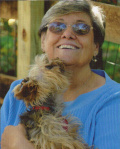 In answer to your question, the setting for my story came first. Several years ago, I visited London’s East End during a trip to England. I honestly felt as though I had stepped back in time, walking the streets of London’s poorest souls, and imagining what it must have been like to live in despair every single day of one’s life.
In answer to your question, the setting for my story came first. Several years ago, I visited London’s East End during a trip to England. I honestly felt as though I had stepped back in time, walking the streets of London’s poorest souls, and imagining what it must have been like to live in despair every single day of one’s life.
Life in Victorian England has been an interest of mine for some time, so I already had done a great deal of reading on the subject. Bu what I chose to focus on in “Suffer the Poor,” were the efforts of both missionaries and members of the wealthier classes to help improve the lives of those less fortunate. And that is what I researched for this story.
Truthfully, my undergraduate days as a sociology major so long ago, never left me. One way or another, the complex nature in which people interact with society provides the foundation for all my stories.
Barb Ross: Terrie Farley Moran, “A Killing at the Beausoliel” incorporates Sassy and Bridgy, the central characters from your Florida-based Read ‘Em and Eat Mystery series. When you write a short story about series characters, how do you decide how much backstory to put in? Also, in this story you do advance the Sassy-Bridgy plot. How do you handle this given some series readers will never read the short story and some short story readers will never read the series? (I’m, er, asking for a friend.)
 Terrie Moran: Hi Barbara, thanks so much for having us visit the Wicked Cozies. I am so excited to be here. I should tell you that the genesis of “A Killing at the Beausoliel” came directly from the readers of the Agatha Best First Novel, Well Read, Then Dead. Shortly after the novel was released, I started to receive lots of e-mails and Facebook messages from readers who wanted to know what happened after Sassy and Bridgy left Brooklyn but before we met them for the first time in the Read ’Em and Eat Café and Book Corner. I suppose it was because in that first book, Sassy mentioned that they had moved to Fort Myers Beach three years earlier and folks were wondering how they spent their time when they weren’t waiting tables and running book club meetings at the Read ’Em and Eat. Were they kayaking in Estero Bay? Were they lying around on the sand at the edge of the Gulf of Mexico working on their tans? Were they sitting around waiting for a murder to investigate?
Terrie Moran: Hi Barbara, thanks so much for having us visit the Wicked Cozies. I am so excited to be here. I should tell you that the genesis of “A Killing at the Beausoliel” came directly from the readers of the Agatha Best First Novel, Well Read, Then Dead. Shortly after the novel was released, I started to receive lots of e-mails and Facebook messages from readers who wanted to know what happened after Sassy and Bridgy left Brooklyn but before we met them for the first time in the Read ’Em and Eat Café and Book Corner. I suppose it was because in that first book, Sassy mentioned that they had moved to Fort Myers Beach three years earlier and folks were wondering how they spent their time when they weren’t waiting tables and running book club meetings at the Read ’Em and Eat. Were they kayaking in Estero Bay? Were they lying around on the sand at the edge of the Gulf of Mexico working on their tans? Were they sitting around waiting for a murder to investigate?
Apparently Sassy and Bridgy’s readers have inquisitive minds. So I decided to write a prequel story which would allow us all to hang out with Sassy and Bridgy on their very first day as Floridians. Given the length of a short story, there isn’t a lot of word count available for backstory, but I felt it was important for the readers to know why Sassy and Bridgy had left Brooklyn.
And you are absolutely right, some series readers will never read the short story and some short story readers will never read the series, so I answered the “why” question briefly in “A Killing at the Beausoliel”. It does come up in every novel in the series because I never know which book a reader will pick up first. As a prequel, the story does advance the reader’s knowledge of Sassy and Bridgy’s history but it still leaves plenty of space between that first day and the opening pages of Well Read, Then Dead. What was going on during those years? Let the readers’ imaginations run wild.
Barb Ross: Edith Maxwell, your story, “A Questionable Death,” was the springboard into your new Quaker Midwife historical mystery series from Midnight Ink. What came first, the idea for the story, or the idea for the series? How did the second emerge from the first?
 Edith Maxwell: Thanks for these great questions, Barb! My story looks like a springboard, but actually Delivering the Truth, the first Quaker Midwife Mystery (released last week!), was in first draft when I wrote “A Questionable Death.” I was already following forthright Quaker midwife Rose Carroll around in 1888 as she catches babies, hears secrets, and solves crimes. At one point during the writing I realized she needed a bestie partner in crime, as it were, so unconventional Bertie Winslow popped into my head. She’s the forty-something postmistress of Amesbury, rides a horse (astride, not sidesaddle) named Grover – after the President – and lives with her lover Sophie in a “Boston marriage.” She and Rose are good friends and get up to some good detecting together.
Edith Maxwell: Thanks for these great questions, Barb! My story looks like a springboard, but actually Delivering the Truth, the first Quaker Midwife Mystery (released last week!), was in first draft when I wrote “A Questionable Death.” I was already following forthright Quaker midwife Rose Carroll around in 1888 as she catches babies, hears secrets, and solves crimes. At one point during the writing I realized she needed a bestie partner in crime, as it were, so unconventional Bertie Winslow popped into my head. She’s the forty-something postmistress of Amesbury, rides a horse (astride, not sidesaddle) named Grover – after the President – and lives with her lover Sophie in a “Boston marriage.” She and Rose are good friends and get up to some good detecting together.I liked Rose, Bertie, the era, and the setting so much I wanted to keep writing about them, and this was before I had the three-book contract from Midnight Ink. When I saw the call for submissions for History and Mystery, Oh, My, I immediately knew the where, when, and who! I just needed to come up with the details of the story. Those came along easily, too, after I read about police attitudes toward domestic violence in those days, and about how it was already possible in 1888 to detect poison from a hair sample. Figuring out the twist at the end was the best part, though!
Thanks, Agatha Best Short Story Nominees. Readers, short stories–yes or no? Favorites? Twisty or straight?
Filed under: Interview Tagged: Agatha award Best Short Story, B. K. Stevens, Barb Goffman, Edith Maxell, harriette sackler, historical mystery, Malice Domestic, Terrie Farley Moran 
April 13, 2016
Wicked Wednesday-Being a Good Panelist
Jessie: In New Hampshire, furiously writing the first draft of my next novel
The Wickeds have all attended conferences for years. We’ve attended panels on topics ranging from craft to social media to unusual poisons. Some of us have moderated panels and we’ve all been speakers. Today I’m wondering what your best advice is for being a good panelist?
Julie: Some of my panelist advice comes from being a panelist. Other advice comes from being an audience member. My best advice is to be an active participant. Listen to other panelists, and react. Smile (make smiling your resting face), nod, and listen. Be prepared (if you know what your panelist is going to say), but adapt to the conversation that is going on.
Jessie: Mine is to sit up straight and to have fun. Make eye contact with people in the audience. If you look bored or uncomfortable it will make the audience feel ill at ease and that is not good for anyone.
Sherry: Don’t take over the panel by talking too long. Everyone on the panel wants a chance to talk about their books too! And do stay in the moment so you don’t have to ask your moderator to repeat the question.
Edith: These are all good. Also: make sure you know at least something about your fellow panelists’ books, including the moderator’s, even if you don’t have time to read them. I was listening to a panel once where the best-known author on it slid in late (on a Sunday morning) and made a crack about how she was the only one on the panel who wrote about a priest/minister/pastor. The books of another author on the panel also featured a priest/minister/pastor. That was just poor form. Know who you’re going to be sitting up there with and what they write.
Barb: Being on a panel is sort of like acting–be in the moment, listen, react. The best panels turn into conversations. Go with, “That’s really interesting, let me add to that.” NOT “I’m waiting for you to stop talking, so I can talk.”
Liz: Much like what everyone’s said. I’ve found establishing a rapport with other panelists as much as you can so you can have a conversation rather than an independent series of comments engages the audience much more.
Filed under: Jessie's posts, Wicked Wednesday Tagged: mystery conferences, panelist, tips, Writing conferences

April 12, 2016
Level Best Books Open For Submission!
Kim in Baltimore still wearing winter clothes.
While you may be planning for the camps your children are attending this summer or where to take your family vacation, I’m thinking about November. That’s right, and I don’t mean turkey either. I’m talking about the next anthology published by Level Best Books. Every year in November at Crime Bake in New England, Level Best Books debuts a new anthology. This year’s short story anthology, Windward, will be the first by the new editors and publishers, The Dames of Detection, of which I am one.
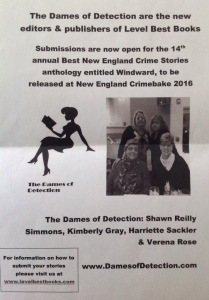

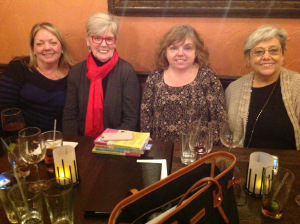
We are actively seeking stories by both established and previously unpublished authors that are in the mystery, thriller, suspense, caper or horror genre.
The stories should not exceed 5,000 words and must be either set in New England or be written by a New England author. Up to two stories will be accepted for review from all authors until May 31,2016.
For full details and guidelines please check our Level Best Books or The Dames of Detection websites.
Level Best Books was founded in 2003 and has now published thirteen anthologies. Stories in these books have won the Agatha, Anthony, Macavity, and Derringer awards as well as the Robert L. Fish award for Best First Short Story which is presented at the Edgars.
Before you sign your child up for summer camp or plan that Memorial Day cookout, send your short story to Level Best Books. Don’t dally, May will be over before you know it. Even if we are still wearing parkas!
Filed under: Kimberly Kurth Gray, Level Best Books, Short Stories, The Detective's Daughter, Uncategorized Tagged: Agatha awards, Anthony awards, award winning, dames of detection, Edgar awards, levelbest books, news england, short stories, submissions

April 11, 2016
A Wicked Good Time in Hollywood
Julie: In MA, thinking about the lovely weather back in CA.
The contest winner of the sock contest is Edie Lewis! Please email your address to Sherry at Sherryharrisauthor@gmail.com
 Sheila, Jessie, Sherry and I all went to Hollywood for a Sisters in Crime conference: Adapting to Hollywood. There we joined 121 other SinC members from across the country, learning about the business of film and television and what we needed to consider when doing an adaptation of our own work. We also got to pitch to a Hollywood producer. I know I am still thinking about the weekend, and mulling over all that I learned. Today, we’re going to chime in on a highlight of the weekend, a favorite memory, and something we learned.
Sheila, Jessie, Sherry and I all went to Hollywood for a Sisters in Crime conference: Adapting to Hollywood. There we joined 121 other SinC members from across the country, learning about the business of film and television and what we needed to consider when doing an adaptation of our own work. We also got to pitch to a Hollywood producer. I know I am still thinking about the weekend, and mulling over all that I learned. Today, we’re going to chime in on a highlight of the weekend, a favorite memory, and something we learned.
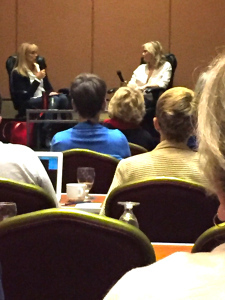
Alison Sweeney talks about working with Hallmark, being a producer, actor, and author.
Jessie: First off, I wanted to send out an enormous thank you to all the people involved in organizing this event. What a tremendous amount of work this must have been! I had such a wonderful time. I learned that while the film business and the publishing business tell stories really differently, they are both industries that require a lot of patience and tenacity. Nothing is over until it is over and enthusiasm goes a long, long way. One of the highlights for me was listening to Megan Abbott talk about her journey towards a seat in the writers’ room on a television show. She was funny and sincere and generous. A favorite memory was sitting with G.A. Maillet, Leslie Budewitz, Sheila, Sherry and Julie late into the evening on the hotel patio talking life and business.
Sheila: Talk about intense! We spent two full days listening to an amazing array of speakers, with different areas of expertise in the film/television/I don’t know what industry, telling us what it’s really like behind the scenes and how to break in. A huge thank-you for Sisters in Crime for putting this together.
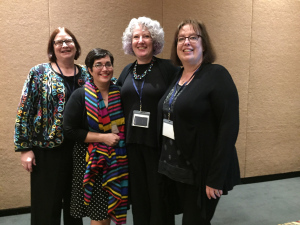 I took a lot of notes, but they don’t always make sense. The first thing that jumped out at me what a comment made by writer Megan Abbott, the keynote speaker: “people in the business don’t live in the same world as other people.” You could say the same for writers. The question we all wanted answered was, where do these two worlds intersect?
I took a lot of notes, but they don’t always make sense. The first thing that jumped out at me what a comment made by writer Megan Abbott, the keynote speaker: “people in the business don’t live in the same world as other people.” You could say the same for writers. The question we all wanted answered was, where do these two worlds intersect?
Other messages? You’d better know someone to get your foot in the door. You need an agent, but your agent needs to know a California agent with connections. There is a lot of demand for IP (intellectual property, which I think means something you wrote that isn’t based on something else) because there are so many outlets for new work–but you still have to get it on the right desk or in front of the right eyes or whatever.
And then there’s the stuff we already know: write a good story, and tell it well. Make even your synopsis or screenplay entertaining. Trust yourself, and don’t lose your own voice. Be persistent and enthusiastic. And keep your fingers crossed!
Sherry: What a fabulous weekend! Thank you Sisters-in-Crime and the LA Chapter of SinC for putting on such a great event. I’m guessing getting all the speakers lined up was right up there with herding cats. And when someone didn’t show up you fixed it! To add to what Sheila said, if you don’t have an agent you can hire an entertainment lawyer to pitch your work to producers, etc. But never send anything on your own or unsolicited.
 Most of you are probably familiar with the IMDb website which is full of information about movies, actors, and TV shows. But I learned in LA there is also an IMDb Pro which lists contact information for producers and executives. They have a thirty day free trial which I
Most of you are probably familiar with the IMDb website which is full of information about movies, actors, and TV shows. But I learned in LA there is also an IMDb Pro which lists contact information for producers and executives. They have a thirty day free trial which I
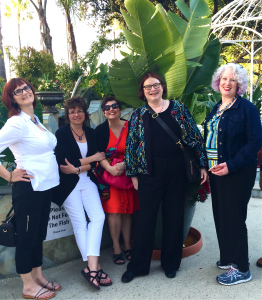
Nancy Parra aka Nancy Coco, Leslie Budewitz, Jessie, Sheila, and Julie
signed up for because I wanted to email someone I had hoped to speak to but didn’t get a chance. So now you can find me on IMDb (for the next 25 days)! I wrote a quick note thanking him for being there and asked if he like my agent to send my books. (Okay, I’m trying not to check my email every five minutes to see if he’s answered.)
Another thing that really struck me is something that Laura DiSilverio said and was reiterated by the speakers over and over. Your art (book) is your art. Hollywood will change it into their art. They might use one aspect, they might not for legal reasons be able to use the names as they appear in your story, they might cut characters for smaller budget TV movies. Lastly, it is always fun to hang out with fellow authors and we had so much fun!
Julie: I took a screenwriting workshop years ago, and couldn’t

After a day of listening walking around the City Walk was fun.
do it. Telling the story through dialogue rather than exposition? I just wasn’t there. But now, one of my takeaways is that I want to try again. The conference was just terrific at explaining in very clear terms that Hollywood is commercial, which is about making money. It doesn’t mean that they don’t care about story, or art (necessarily). It does mean that budgets and potential income matter.
I also thought about how lucky we are as novelists. Though we need people in our production pipeline (editors, publishers, booksellers, librarians, readers, etc.) our imagination is our own movie studio. It is a special skill, but not necessarily transferable.
What a terrific weekend. I learned a lot, and look forward to learning more. The dream is still to have a movie on the Hallmark Channel. I am grateful to Sisters in Crime for helping me realize this will be as big a challenge as getting published.
Any other sibs want to weigh in on what they learned last weekend?
Filed under: Conferences Tagged: Adaptation, G.A.Maillet, Hollywood, IMDb, IMDbPro, J.A. Hennrikus, Jessie Crockett, Learning, Leslie Budewitz, Megan Abbott, sheila connolly, Sherry Harris, Sisters in Crime, Wicked Cozy Authors

April 9, 2016
Sock It To You
Jessie, Julie, Sherry and Sheila all attended the Adapting to Hollywood conference sponsored by Sisters in Crime in Los Angeles last weekend. We had a little free time in the evening and came across a store called The Los Angeles Sock Market. It’s slogan is World’s Greatest Sock Store and let us tell you — we all (Nancy Coco and Leslie Budewitz were with us too) agreed. We loved Susannah’s post about what she’d buy us at a flea market we decided to do the same thing with socks!
For Jessie’s new Change of Fortune series:
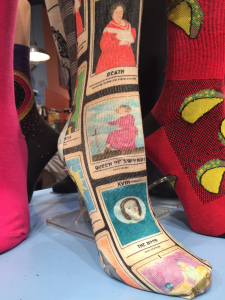
Tarot card socks

And since the series is set in Old Orchard Beach, Maine — seagulls and pier fries!
For Sherry since Sarah Winston loves pizza:


Julie had to have clock and clock part socks:
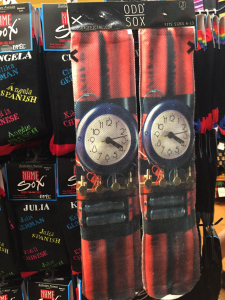

In Edith’s Country Store Mysteries Robbie is not only a cook but a carpenter:


Liz, we found you a bunch of cat socks:
 Barbara of course it was lobster socks:
Barbara of course it was lobster socks:


We choose Irish socks for Sheila:

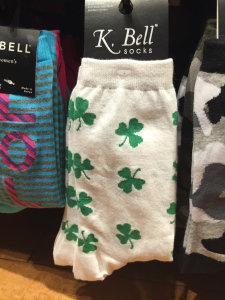
Kim we found you crab socks for Baltimore:

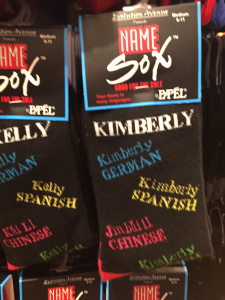
And Susannah we found you olive socks for Olive and Let Die:


It was hard to leave these Wicked socks behind!
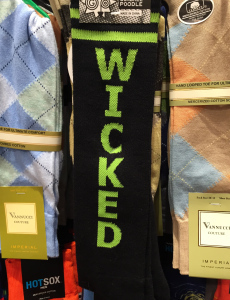 Readers we couldn’t leave you out so we are giving away these fabulous socks to one commenter!
Readers we couldn’t leave you out so we are giving away these fabulous socks to one commenter! 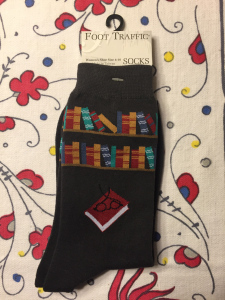
Filed under: Uncategorized Tagged: Socks, The Los Angeles Sock Market, World's Greatest Sock Store

April 7, 2016
Delivering the Truth-Happy Book Birthday, Edith!
Jessie: In NH, where spring has gone back into hiding.
Today the Wickeds are delighted to be celebrating Edith’s newest release, Delivering the Truth!  This has been a real passion project for Edith and we couldn’t be happier for this day to arrive! Since historical fiction acts as a sort of time travel mechanism, I thought I’d ask you all which famous person from 1888 would you like to meet if you could?
This has been a real passion project for Edith and we couldn’t be happier for this day to arrive! Since historical fiction acts as a sort of time travel mechanism, I thought I’d ask you all which famous person from 1888 would you like to meet if you could?
Jessie: I would love to meet E.F. Benson, the author of the Lucia books. I re-read them almost every year and would so enjoy meeting their creator!
Sherry: There were a lot of interesting people alive in 1888. I couldn’t settle for just one. First up is Louisa May Alcott. She died March 6, 1888 but oh, to talk to her. She lived a hard but interesting life, and knew so many fascinating people. I’ve been to Orchard House (where she wrote Little Women) and visited her grave on Authors Ridge at Sleepy Hollow cemetery in Concord. And across the pond, Sir Arthur Conan Doyle. I’m intrigued not only by his writing life but in his interest in spiritualism. Edith, I’m so happy for you!
Barb: Such a rich cast of characters to choose from. I think I have to go with Edith Wharton. In 1888 she was only 26 and not yet published, so she wasn’t who she was going to be. But that woman was such an amazing talent and bundle of contradictions as a person, I can’t pass up any opportunity to better understand what made her tick. (Plus, wouldn’t it be fun to come back and give some Edith Wharton scholars the straight scoop? Sort of like that scene with Marshall McLuhan in Annie Hall.) Good luck, Edith. Delivering the Truth has landed on my iPad. Can’t wait to read it!
Liz: Mark Twain, definitely! In 1888, it would’ve been a few years after Huck Finn was published and the year Twain’s humorous works, Library of Humor, came out. I wouldn’t miss a chance to pick the brain of such a famous writer. Edith, so excited for this new adventure of yours!
Julie: 1888 was such an interesting time. Susan B. Anthony, Frederick Douglas, Oscar Wilde, Elizabeth Cady Stanton, Lotta Crabtree were all around, and changing the world. (Who is Lotta Crabtree, you may ask. One of the rich characters in Boston’s theater history.) Any one of those people would be amazing. Do you think they had any inkling of their place in history? Edith, I am SO happy for you on this launch. I love seeing how excited you are, and can’t wait to read Delivering the Truth!
Edith: These are all fabulous. Imagine if we had them all in the same room. Two more are the real female detectives from the 1800s that I’m talking about over on the Mysteristas blog today.
Thank you, my dear blog sisters, for helping me get to this day. I’m thrilled!
Filed under: Book Birthday, Book Release, Group posts, Jessie's posts Tagged: amesbury, Authors Ridge, book launch, book release, Delivering the Truth, Edith Mawell, Edith Maxwell, historical mysteries, Louisa May Alcott, Orchard House, Quaker Midwife Mysteries, Quakers, Sir Arthur Conan Doyle, Sleepy Hollow Cemetery

Murder Then and Now
 Edith here, delighted that Delivering the Truth releases…tomorrow!
Edith here, delighted that Delivering the Truth releases…tomorrow!
Because I write an historical murder mystery series as well as two contemporary ones, I got to thinking about the ways killing someone in 1888 might be the same or different from now.
Certainly, pushing a victim over a cliff or beating them to death with a large blunt object hasn’t changed in the last 130 years. There were stabbings and shootings then, just as we hear about now. But did unique murder methods exist in the era of my Quaker Midwife Mysteries that wouldn’t or couldn’t be used today?
Death by hatpin comes to mind. When bonnets gave way to hats in the late 1800s, Wiki pedia says, the use of hatpins soared. And a couple of decades later, the same article states, “Laws were passed in 1908 in America that limited the length of hatpins, as there was a concern they might be used by suffragettes as weapons.” Hatpins were about eight inches long and had a decorative head to hang onto. Sounds like a good weapon to me, and an article at Smithsonian.com backs me up.
pedia says, the use of hatpins soared. And a couple of decades later, the same article states, “Laws were passed in 1908 in America that limited the length of hatpins, as there was a concern they might be used by suffragettes as weapons.” Hatpins were about eight inches long and had a decorative head to hang onto. Sounds like a good weapon to me, and an article at Smithsonian.com backs me up.
And then there were the readily available poisons. You could buy aresenic-containing rat poison at any hardware store, which I used in my Agatha-nominated short story, “A Questionable Death.” Cyanide and strychnine were also widely used. Today all these are highly regulated and unlikely to be a contemporary murder weapon.
 Opium is another good one. When dissolved in alcohol, it was called laudanum. In Rose Carroll’s day, it was sold without a prescription and used to relieve pain, including that of menstrual cramps, induce sleep, and calm the nerves. But because it’s a depressant, taken in excess it can induce coma and death, according to Kathryn Harkup’s excellent book, A is for Arsenic: the Poisons of Agatha Christie. Sadly, we hear about too many heroin deaths even today.
Opium is another good one. When dissolved in alcohol, it was called laudanum. In Rose Carroll’s day, it was sold without a prescription and used to relieve pain, including that of menstrual cramps, induce sleep, and calm the nerves. But because it’s a depressant, taken in excess it can induce coma and death, according to Kathryn Harkup’s excellent book, A is for Arsenic: the Poisons of Agatha Christie. Sadly, we hear about too many heroin deaths even today.
One modern poison likely not used in 1888 is liquid nicotine. With the rise of vaping, tiny vials of liquid nicotine can be bought anywhere. According to Luci Zahray, the Poison Lady, two cartridges will kill an adult. Tylenol didn’t exist back then, either, so it couldn’t be combined with alcohol to destory someone’s liver (see my short story, “An Idea for Murder“).
nicotine can be bought anywhere. According to Luci Zahray, the Poison Lady, two cartridges will kill an adult. Tylenol didn’t exist back then, either, so it couldn’t be combined with alcohol to destory someone’s liver (see my short story, “An Idea for Murder“).
Readers: Do you have a favorite Victorian murder weapon?
Filed under: Edith's posts Tagged: A is for Arsenic, An Idea for Murder, Delivering the Truth, Luci Zahray, Midnight Ink

April 6, 2016
Wicked Wednesday – Packing for Travel
Jessie: In NH where the first of the daffodils are in bloom!
This month the Wickeds have a lot going on, and much of it involves travel. So today I’d like to know, do you overpack, underpack or hit that elusive perfectly filled bag when you go on a trip?
Edith: If I’m driving, I always overpack. Because, hey, I can. Actually, I probably  always overpack. I don’t think I’ve ever come home having worn or used every item in my suitcase. I think, “What if that top doesn’t look good?” “What if the weather changes?” But the Kindle has solved one problem: overpacking books. Now I can bring twenty books for the weight of one! I’ll bring one paper book in case of power outage of whatever, but I love the Kindle.
always overpack. I don’t think I’ve ever come home having worn or used every item in my suitcase. I think, “What if that top doesn’t look good?” “What if the weather changes?” But the Kindle has solved one problem: overpacking books. Now I can bring twenty books for the weight of one! I’ll bring one paper book in case of power outage of whatever, but I love the Kindle.
Sherry: Really? You had to bring up packing! Right after I confessed to you and Julie while we were in LA last weekend that I’m always forgetting something? Well, I guess Julie knew since we roomed together at Left Coast Crime where I forgot pajamas (went to the gift shop and bought an overpriced Tshirt) and toothpaste (Julie shared). And for both LCC and the Adapting to Hollywood conference I forgot to take my books! As discussed with Julie and Jessie I’m planning to pack a go bag that has everything I need in it. And I always over pack — apparently it’s just not everything I actually need.
Julie: I tend to overpack. But this past weekend, I decided I needed to limit myself to my smaller suitcase. I was also determined not to unzip the extender. So, how did I do? I wore mostly black, which helped with the mix and match. I tried to only bring the cosmetics I would use (which at my age still took up 1/3 of the suitcase, but hey, I tried). I brought my ballet flats and wore my sneakers. I also brought layers. Conference packing pro tip: always bring your books and bookmarks. You can mix and match, but you do need to look polished, so jackets or sweaters help. Jewelry makes any outfit look different, and is small. And don’t forget your power cords.
Filed under: Wicked Wednesday Tagged: Go bags, over packing, packing, traveling, traveling tips, trips, Wicked Cozy Authors, Wicked Wednesday


